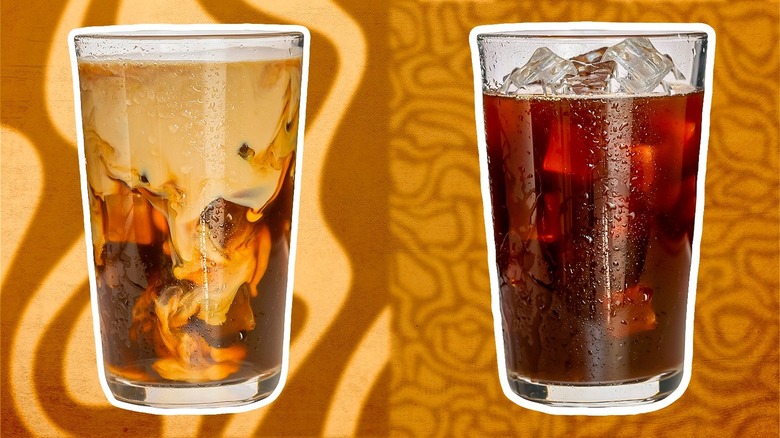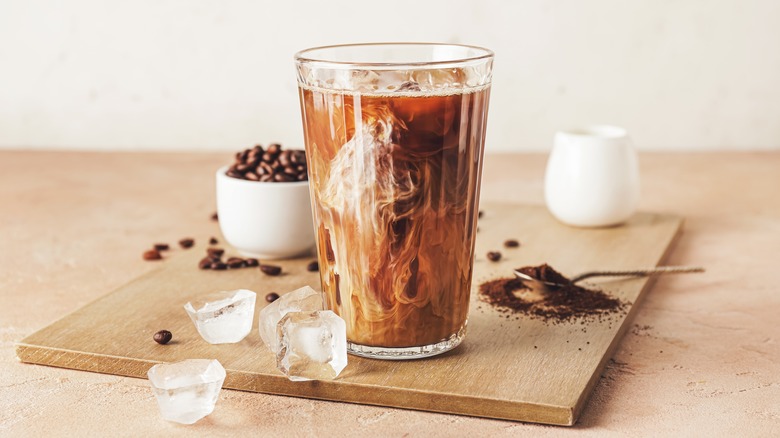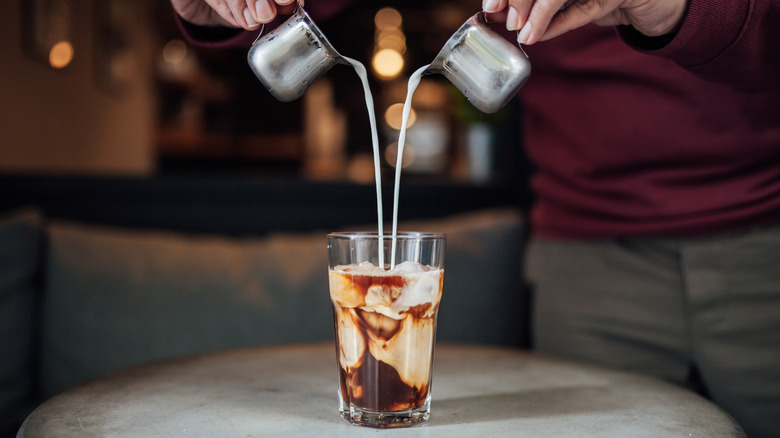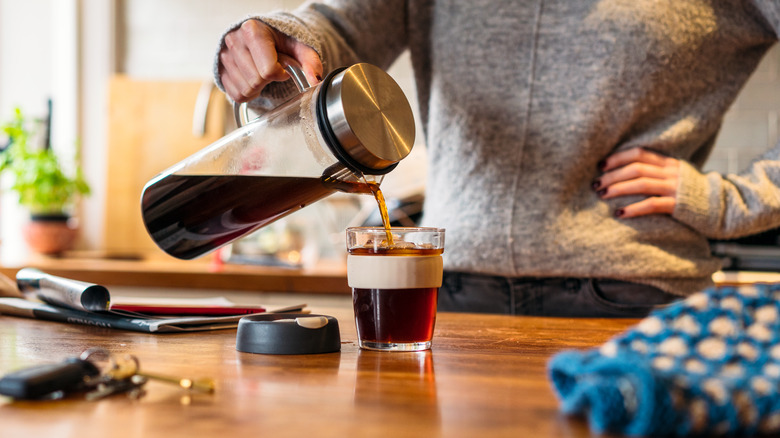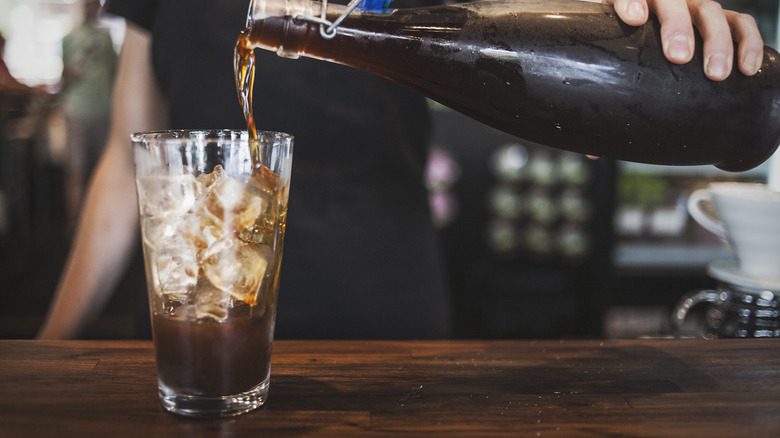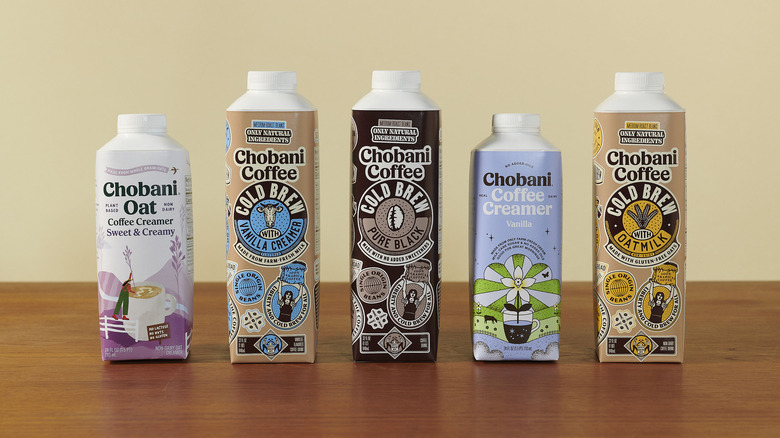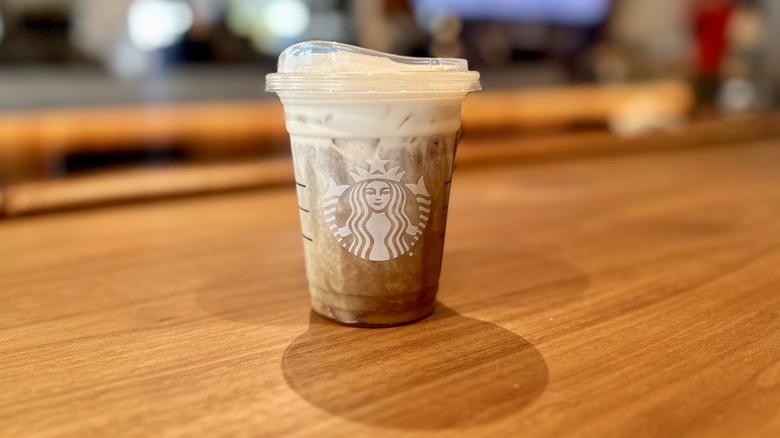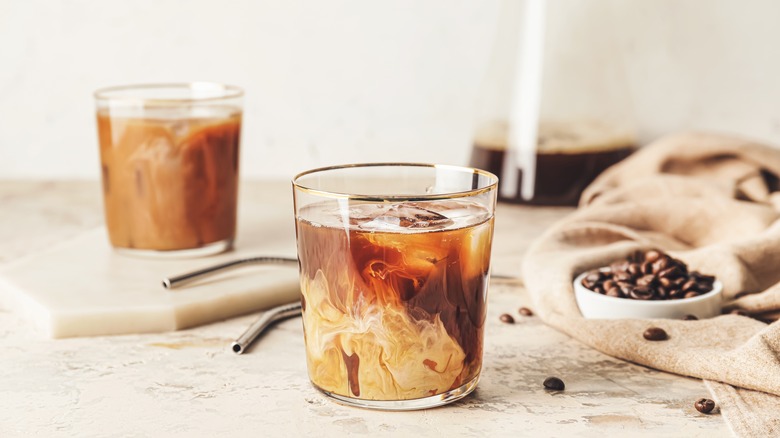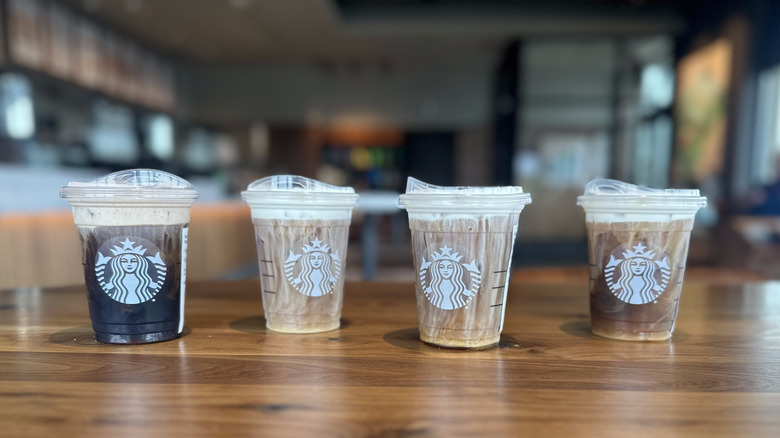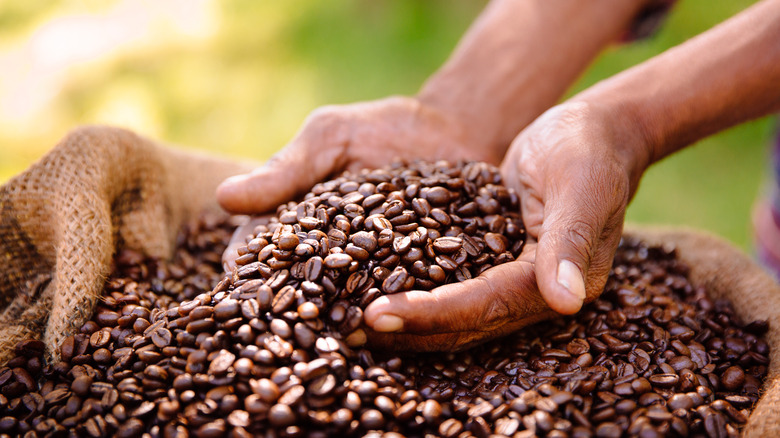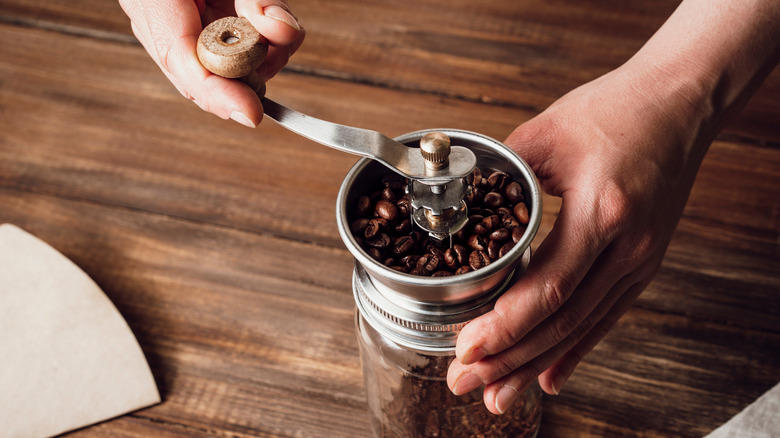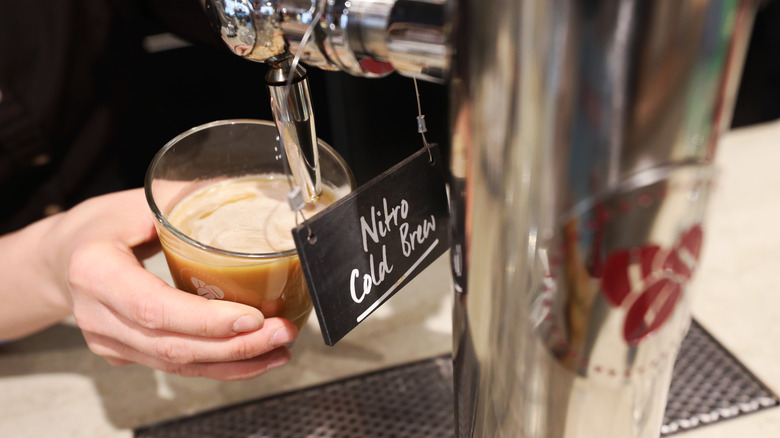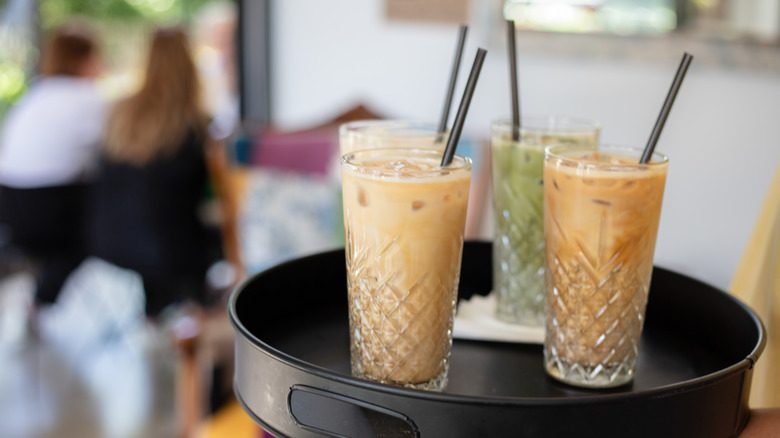Cold Brew Vs. Iced Coffee: What's The Difference?
For many of us, cold coffees are a year-round obsession. Whether the mercury dips to freezing or soars in the summer sun, there's a special allure to sipping a chilled coffee beverage. And if you're someone who routinely orders cold coffee, even when everyone else is warming their hands with hot lattes, you've likely noticed the rise of cold brew on the menus of your go-to coffee joints. From major chains to quaint local cafes, cold brew has steadily cemented its place as a favored drink. Its simplicity makes it a hit not just in coffee houses but also among home-brewing enthusiasts.
But if you're new to the cold brew scene, you might be scratching your head. Why the hype? What sets it apart from its close cousin, iced coffee? And why does it often come with a heftier price tag? While cold brew and iced coffee both fall under the category of chilled coffee beverages, their brewing methods diverge significantly, resulting in distinct flavors and profiles.
What is cold brew?
Cold brew is not just another term for cold coffee. Rather, it refers to a unique brewing method that differentiates it from its hot-brewed counterparts. In essence, cold brew involves steeping coffee grounds in water at room temperature or even colder for a prolonged period. Unlike hot coffee, which extracts flavors rapidly due to the high water temperature, cold brewing necessitates a longer duration for the coffee grounds to impart their flavors fully into the water.
The result is a smooth, rich, and often less acidic coffee concentrate that can be diluted to one's preference. Once the brewing process is complete, the cold brew is ready to be poured over ice and embellished as desired. Whether you're a purist who prefers it straight or someone who enjoys a hint of sweetness and creaminess, the versatility of cold brew allows for myriad delicious additions. One of our favorite ways to elevate cold brew's flavor is by incorporating seasonal coffee syrups and topping it off with homemade cold foam made from a preferred coffee creamer. This method not only adds depth to the drink but also offers a delightful textural contrast, making every sip a gourmet experience.
What is iced coffee?
Iced coffee is more than just hot coffee served over ice. It's a refreshing take on the traditional hot brew, tailored to provide a chilled caffeine fix, especially appreciated during warmer months. At its core, iced coffee is brewed hot and then cooled down, either by refrigeration or by immediately pouring it over ice.
Some opt to brew coffee at a slightly higher strength to ensure that the brew retains its robust flavor when poured over ice, compensating for the dilution caused by the melting cubes. An effective strategy to maintain its flavor intensity is to prepare the hot coffee in advance. For instance, brewing the coffee the night before and refrigerating it ensures that the beverage remains less diluted and chilled when poured over ice the next morning. This approach not only ensures consistency in taste, but also makes for a convenient and quick morning routine.
For those who want undiluted coffee but might not have the time for nightly brewing, there's an ice cube trick that won't water down your iced coffee: coffee ice cubes. By freezing brewed coffee in ice cube trays, the melting ice only adds to the coffee's flavor rather than watering it down. This method requires foresight, as the coffee needs to be brewed and then frozen in advance, but the result is a deeply flavorful and consistently chilled drink. These cubes make every sip of iced coffee rich and satisfying, ensuring that neither taste nor temperature is compromised.
Cold brew has a bolder flavor
Cold brew coffee is distinct not just in its preparation method, but also in the flavor profile it presents. When you compare a glass of cold brew to iced coffee, the differences in taste become evident. Cold brew coffee typically boasts a bolder, richer, and more intense flavor. This is largely because of the prolonged steeping process, which allows for a more thorough extraction of flavors from the coffee beans.
The choice of coffee beans plays a pivotal role in shaping the final taste of cold brew. If you're partial to flavored coffee, you'll find that the inherent flavors — such as vanilla, hazelnut, or caramel — become more vivid and pronounced in a cold brew. Conversely, if your palate leans towards darker roasts, you can expect an even richer and more robust flavor from a cold brew. The prolonged steeping doesn't just extract the flavors; it amplifies them.
Steeping beans for cold brew takes a while
Cold brew coffee preparation is not speedy, and requires some patience. You'll want to allow those ground beans to steep in room-temperature water for at least 12 hours. The more time, the merrier — until the 24 hour mark. Keep steeping much past that, and your cold brew, which should be quite smooth, will actually turn bitter on you. The longer you steep your coffee, the stronger it will be.
Since you can manage the amount of steeping time you choose at home, we recommend fine-tuning your timing to whatever tastes best to you, and to suit the way you like to enjoy your coffee. For example, if you're a speedy iced coffee drinker, you'll probably find a solid steep time around the 14 hour mark. On the other hand, if you tend to sip your drinks over a long period of time, consider something closer to an 18 hour steep. This way, your coffee can withstand the added water it'll continually accumulate from melting ice as you drink your coffee over a longer while.
Cold brew's popularity is rising
Cold brew coffee is not merely a fleeting trend in the coffee world; it's steadily securing its place on the menus of many coffee shops and chains. If you're a regular at these cafes, you've likely observed the increasing prominence of cold brew offerings. This observation is not mere perception, as industry statistics validate the growing popularity of cold brew. According to Statista, the cold brew market was valued at approximately $166 million in 2017 — and by 2025, this value is forecasted to reach about $944 million, signifying the drink's growing demand.
Both boutique coffee shops and global chains are jumping on the cold brew bandwagon. Starbucks, for instance, has incorporated cold brew drinks into its seasonal offerings, and some of these are even eclipsing longtime favorites. A notable example was the Pumpkin Cream Cold Brew, introduced by Starbucks in 2019 — by 2020 it astonishingly outsold the perennial-favorite Pumpkin Spice Latte.
The rise of cold brew doesn't stop at cafes. The retail market is burgeoning with a variety of cold brew options from numerous coffee brands. These ready-to-drink offerings are a real win for those with packed schedules, providing the taste of freshly brewed cold coffee without the wait. This convenience ensures that even those pressed for time can savor the rich flavors of cold brew whenever they desire.
The caffeine content can be higher in cold brew
Cold brew's heightened caffeine content is one of its attributes that many enthusiasts rave about. In comparison to regular iced coffee, cold brew generally boasts a higher caffeine concentration. For instance, at Starbucks, a grande iced coffee contains approximately 165 milligrams of caffeine, whereas its cold brew counterpart of the same volume has about 205 milligrams. However, this isn't a universal trend. Taking Dunkin' as an example, a medium iced coffee delivers 297 milligrams of caffeine, whereas their cold brew variant offers 260 milligrams, marking a notable decrease in caffeine content.
The reason why cold brew coffee isn't always stronger than regular coffee primarily hinges on the bean-to-water ratio used during preparation. The initial concentration of caffeine in cold brew is often higher due to a more concentrated brewing process. However, when additional components like milk, ice, and flavorings are introduced, the overall caffeine intensity can be diluted. Thus, while cold brew usually starts out as a stronger concoction, the final caffeine content can be influenced by various factors, including the added ingredients and the specific brewing method employed in making it.
Cold brew isn't as harsh on your stomach
On those particularly hectic days, especially after sleep-deprived nights, overindulging in coffee can sometimes lead to unpleasant side effects. It's not uncommon to experience heightened acid reflux or mild stomach discomfort after consuming excessive caffeine. While the idea of relinquishing our beloved coffee is unthinkable, the discomfort can be hard to ignore. This is where cold brew comes to our rescue. Not only does it provide a potent caffeine boost, but it also boasts a reduced acidity level compared to its hot-brewed counterpart.
This decrease in acidity can be a blessing for those with sensitive bellies, because the lower acid level means that cold brew coffee is easier on your stomach. Although the reduction in acid content may not be drastic, for many of us, even a minor change can make a significant difference. Opting for cold brew may allow us to enjoy the energizing benefits of coffee without compromising our digestive comfort. It's certainly a benefit to keep in mind if acidic coffee is a concern for you.
Starbucks has specialized cold brew offerings
With its menu rotating year-round, Starbucks continually presents a variety of cold brew options that go beyond the customary offerings. While the chain does roll out seasonal sensations like the Pumpkin Cream Cold Brew in the autumn and the White Chocolate Macadamia Cream Cold Brew for summertime, its regular cold brew repertoire is far more expansive and dynamic compared to its iced coffee selections.
When it comes to iced coffee, the choices are pretty limited. You can opt for a simple iced coffee, its milky variant, or espresso on the rocks. Although customization is possible with flavor or milk choices, the base offerings do not have a diverse range of flavors or unique additions.
On the other hand, the cold brew menu offers a nice variety of flavors with rich toppings and intriguing infusions. Whether you're in the mood for the velvety allure of Vanilla Sweet Cream Cold Brew, the indulgence of Chocolate Cream Cold Brew, or the harmonious blend of sweet and salty in the Salted Caramel Cream Cold Brew, there's something for you. These specialty cold brew drinks, topped with luscious cold foam and infused with sweet syrups, are not only a testament to the growing demand of cold brew but also highlight its adaptability and ability to cater to a range of palates and preferences.
Cold brew tastes best with low-acidity beans
Since many people choose cold brew because it's less acidic on the stomach, it would track that you'd also look for a less acidic bean to make your cold brew. In most cases, this will be a bean with a medium or darker roast. It may be tempting to choose a more acidic blond roast, with its lighter and often fruitier notes, but the prolonged steeping inherent to cold brew preparation can sometimes alter and overpower the delicate nuances of such roasts.
However, navigating the world of cold brew isn't just about understanding roasts and acidity levels. The journey to crafting the perfect cold brew is deeply personal. A common mistake for cold brew lovers is not allowing for the freedom to experiment. Finding the best bean for your cold brew often requires a process of trial and error. Different beans, even with similar roast profiles, can yield vastly different flavor profiles when brewed cold. By giving yourself permission to explore and taste-test various beans, you're not only refining your palate but also inching closer to that perfect cold brew blend that resonates with your unique taste preferences.
Choose a medium-course setting for grinding cold brew
Selecting your coffee beans is just the first step in the cold brew journey. The next critical decision revolves around choosing the absolute best grind size for cold brew coffee, which can significantly impact the flavor profile of your brew. Espresso demands a very fine grind because water interacts with the grounds for only a short time, necessitating a quicker extraction process. However, cold brew involves a prolonged steeping process. As such, a coarser grind is more suitable. This coarser texture not only ensures a smoother extraction but also helps prevent the brew from becoming overly bitter.
If you're shopping at a grocery store equipped with an in-aisle grinder, you're in luck. These machines often have settings tailored for different brewing methods, including one for a coarse grind perfect for cold brew. However, if you're grinding at home, exercise caution. It's easy to overdo it. To maintain consistency and avoid overgrinding, consider grinding your beans in smaller batches. This method ensures you have better control over the texture and reduces the risk of ending up with a grind that's too fine.
For those who prefer a hassle-free approach, many specialty coffee providers offer pre-ground beans specifically calibrated for cold brew. While freshly ground beans usually provide a richer flavor, pre-ground coffee tailored for cold brew can be a convenient alternative, especially if you're pressed for time or don't own a grinder.
Nitro cold brew is a creamier cold brew option
Nitro cold brew is, in essence, the sophisticated cousin of traditional cold brew. The primary distinction is with the infusion of nitrogen gas, transforming the drink both in texture and flavor. The introduction of nitrogen results in tiny bubbles that give the coffee a velvety, almost creamy feel, even though the base beverage contains no dairy. This silky texture not only enhances the drinking experience but also brings a subtly sweeter taste.
Aside from the taste and feel, another big difference is in the look of the coffee. Simply put, it's quite lovely. The drink appears to cascade down like you see with a nitrogen-infused beer like Guinness. However, it's essential to remember that nitro cold brew is typically served without ice, which is part of the reason this cascade works. While this ensures that the drink remains undiluted and preserves its creamy consistency, it also means that it may not be as cold as you might expect or prefer. For those who enjoy the refreshing sensation of iced beverages, this might be a point of contention. Still, many coffee enthusiasts adore nitro cold brew for its unique characteristics and consider it a refreshing deviation from the norm.
Iced espresso drinks are different from iced coffee
In the diverse landscape of cafe menus, you're sure to spot iced lattes alongside the many types of iced coffee. At the heart of their distinction is a key ingredient: espresso. With an iced latte, you're essentially getting a fusion of espresso, milk, and any chosen flavorings, all poured over ice. This results in a refreshingly cold beverage and delivers a more potent caffeine kick. That's because espresso, by its very nature, is a concentrated brew, packing more flavor and caffeine into a smaller volume compared to regular coffee.
For those seeking an even more intense espresso experience, check out the shakerato. This drink is a delightful concoction where espresso is vigorously shaken with ice, yielding a frothy, chilled shot with a smooth finish. If you're looking for a similar taste adventure in popular coffee chains, Starbucks offers a shaken espresso, providing that robust espresso kick with a cool, refreshing twist.
A iced mocha is yet another iced espresso drink you'll often find on menus. This drink is similar to an iced latte, but instead, it includes mocha sauce. This chocolate addition is what sets a mocha apart — and as a bonus, iced mochas are often topped with whipped cream.
